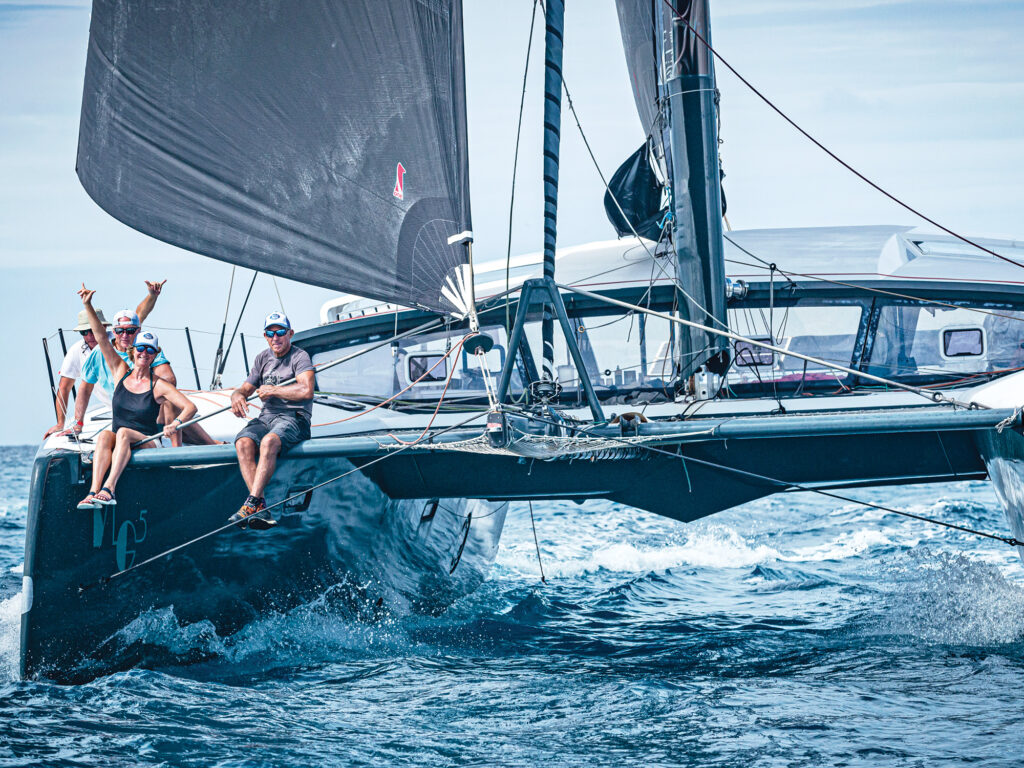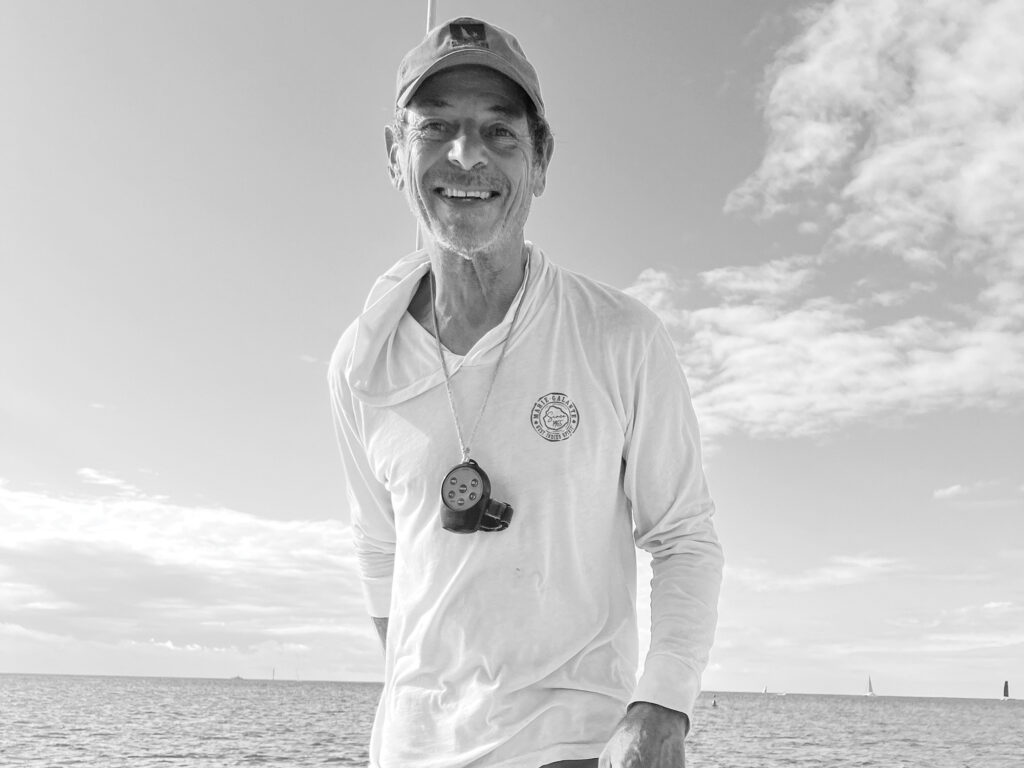
The French are different from us. After years of covering offshore sailing, particularly the shorthanded scene, that’s always been my take. What event could possibly be more French than the Vendée Globe, the quadrennial nonstop solo race around the planet on foiling IMOCA 60 rockets that’s front-page news in France for months on end, mainly because impending catastrophes and daring Southern Ocean rescues are seemingly daily occurrences? From ports along the Brittany coast and elsewhere, this nation produces the best ocean-racing specialists, and in my opinion, the greatest among them is ironman Francis Joyon, who holds or has held almost every major voyaging record, including winning the Jules Verne Trophy in 2017 for circling the globe in just over 40 days.
Surprisingly, given their prowess across multiple racing venues, the French have always mounted horrible America’s Cup campaigns, but even there, they’ve put their personal stamp on it. When ballpoint-pen magnate Baron Bich was consistently getting smoked in his four challenges during the 12-Metre days, the old joke was we could always tell that the French were about to tack when the crew flicked their cigarettes over the side.
All that said, other than occasional boat reviews with French sailboat manufacturers, I’d never really gone sailing with an all-French squad. That changed early this past February, when I score a ride with legendary competitor Marc Guillemot and his team for a day of racing off St. Maarten in the annual Caribbean Multihull Challenge Race and Rally. I’m eager to discover if the French boys are really playing the game differently.
Guillemot has enjoyed a long and productive career, the highlight of which was his third-place win in the 2008 Vendée aboard his IMOCA 60, Safran. Now in this mid-60s, his latest boat is a Christophe Barreau-designed 53-foot MG5 catamaran called Dazelad, roughly translated as “alternative” in English, as a nod to its innovative carbon construction and upcycled components.
“He’s won a lot of stuff and wanted his own personal boat, his home; it’s not about sponsors,” says French yachting journalist Emmanuel van Deth, who’d hooked me up with Guillemot. “It’s a compromise, so he can cruise with friends or race with friends.”
As a compromised “retirement” vessel that Guillemot plans to charter occasionally to offset expenses, it’s still pretty quick: He nabbed an impressive third place on its maiden voyage in the 2022 Route du Rhum.
Like jockeys and movie stars, it’s always a little jarring to meet French solo sailors in person; Joyon is a certified beast, but most of them are of rather diminutive stature, as is Guillemot. His English is spotty (but way better than my French), but he has an easy, elfin smile, and an extremely laid-back demeanor. I like him immediately. His extremely cool boat, in spirit and execution, is a crazy work of nautical art, the sum of many disparate parts.
Guillemot conducts a quick tour, which is fascinating. Much of the gear is stuff he scavenged from Safran. But that is just the start of it. It is in many ways a history of and tribute to the French singlehanded racing scene, with contributions from Guillemot’s many IMOCA pals. The rudder is from one of Jérémie Beyou’s old boats; Damien Seguin supplied the daggerboards; the running rigging is off Loick Peyron’s Gitana; Jean Le Cam donated an old spar. If Frankenstein’s monster were a boat, it would be Dazelad.
The crew of close friends, including Guillemot’s brother, Regis, who dinghies over from his big cruising cat, is also notable. Longtime pro sailor and sailing writer Nicolas Raynaud is a jolly, Falstaffian character with a ready laugh and a twinkle in his eye who definitely seems like a kindred soul.
His polar opposite is tactician Bruno Jourdren, quiet and studious, who’d suffered a serious accident in his youth that had permanently damaged his right arm; he sails with his hand always in his pocket. A three-time Paralympic sailor, he has also cleaned up in dedicated one-design classes such as the Melges 24, where he is a former national champion.

Before the day’s first race, Guillemot and Jourdren, huddled prerace over an iPad with the sailing instructions, are clearly very tight. Van Deth speaks of the latter in almost reverential terms: “They call Michel Desjoyeaux ‘the professor’ because of his navigational approach, but when it comes to tactics, Bruno is also considered an academic. If he says, ‘Go left,’ you go left. You do not question him.”
The most I can get out of Jourdren is a raised eyebrow, which is pretty much in keeping with all the previous professors in my life.
It is a strange day, weather-wise, for the Caribbean; the generally pumping, reliable easterly trade winds are on hiatus, replaced by an unusual northwest breeze of 10 knots. With a downwind start, there is a short debate about the merits of an asymmetric kite versus a code zero headsail, with the latter getting the call. I am relegated to the foredeck with Regis and Van Deth to furl and then unfurl the code zero through tacks and jibes. Foolishly, I’ve brought only flip-flops, thinking I’d sail barefoot, as I often do in the islands. But the trampolines on Dazelad are like razor wire, and footwear is a must. Rookie mistake.
Thanks to the headsail discussion, we are slightly late for the start, but once the code zero is sheeted home and Dazelad begins manufacturing its own apparent wind, we take off, easily notching 12-plus knots, and Desjoyeaux carves through the pack and picks off the competition (though there was no catching the HH66 and Gunboat 66 at the front of the fleet). The French are cooking.
There is a refreshing squall on the last tack to the finish line in a race with a little bit of everything, including a couple of lulls in the breeze. Guillemot seems pleased and philosophical with the midfleet result. “Under 12 knots [of wind], not so good,” he says. “Twelve or more, that’s when we go.”
The sun pops out and the breeze pipes up for Race 2, and Dazelad is in jailbreak mode off the starting line, ripping around the racecourse with average speeds in the midteens. The cat spins through tacks and jibes like a Hobie, and noticeably accelerates in every puff. The results aren’t any different from the first race, but the sailing itself is fantastic.
And then comes lunch. In this aspect of actual French cooking, there is no question that they will raise the bar. Raynaud has effortlessly whipped together a fresh pasta dish brimming with cucumbers, melons, avocado and cheese that is nothing less than magnificent. An obligatory break for a cigarette caps off the meal. Très bien, mon ami.
It is apparently an inspiring repast as Guillemot crushes the start for the third and final contest of the day. At this stage, spinning around the same triangle course off the southern coast of St. Maarten, the entire exercise is beginning to feel a little like Groundhog Day. By this time, however, we’ve become a pretty well-honed team, and our maneuvers are fairly flawless, if I do say so myself. For this race, the only cats ahead of us at the end are the pair of 66-footers. In surfing, it’s often been said that the best surfer is the one who’s having the most fun. If that’s also the case in sailboat racing, Dazelad is the day’s clear-cut winner. Raynaud, who is rapidly becoming my idol, passes out cold beers all around.
And then, at the literal end of the day, Guillemot and his mates hastily put away the boat. They have another important appointment. The French rugby team is about to play an international match with Ireland, and they are eager to get to a bar in Marigot on the island’s French side to watch the action. Yes, they are on their merry way to guzzle brews and basically watch football. Hmm. That’s when it hits me: Maybe these French dudes aren’t so different from us after all.









